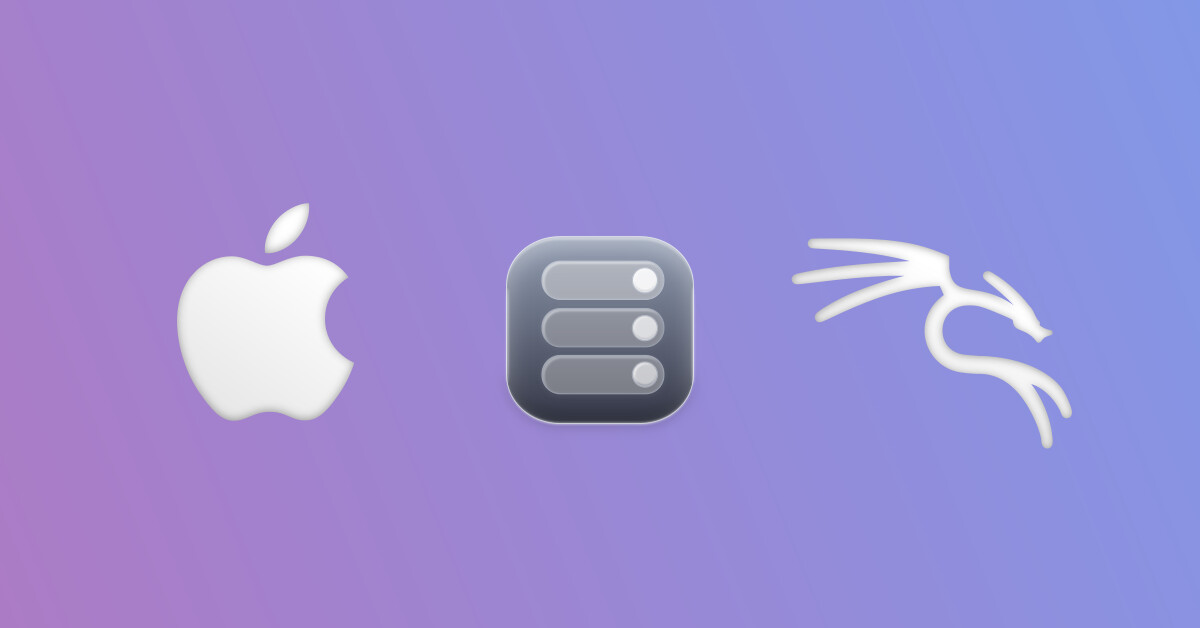
Kali Linux & Containerization (Apple's Container)
Table of Contents
If you’re an Apple user, you may have heard of Apple’s upcoming feature Containerization during WWDC 2025.
Quick summary:
Containeris a CLI tool, which works with Containerization. This is what end-users interact with.Containerizationhandles creating the containers, that talks toVirtualization.framework.Virtualization.frameworkis the hypervisor API (high level), and creates a new VM per container viaHypervisor.framework.Hypervisor.frameworkis the low level hypervisor API, which uses the macOS kernel (the hypervisor).
It is similar to Microsoft’s Windows Subsystem for Linux 2 (WSL), where a very small lightweight virtual machine (VM) is launched in the background, so a Linux kernel can be used on a non Linux host (WSL2 uses Hyper-V). Not to be confused with WSL1, which was more like WINE!
Its set to be publicly released for the next major OS release, macOS “Tahoe” 26, and also for macOS “Sequoia” 15 .
Containerization supports containers which are “Open Container Initiative (OCI) compliant”, luckily our Kali image are!
Setup
If the first thing we see when trying to run container is:
~ % container
zsh: command not found: container
~ %
…We need to install it.
Doing a quick check to make sure our system is supported:
~ % sw_vers -productVersion
15.5
~ %
~ % uname -m
arm64
~ %
We are using macOS 15.5, on an Apple Silicon series device (aka arm64).
We are good to go!
If Homebrew is installed:
~ % brew install --cask container
==> Downloading https://github.com/apple/container/releases/download/0.2.0/container-0.2.0-installer-signed.pkg
==> Downloading from https://release-assets.githubusercontent.com/github-production-release-asset/993475914/c5fb6a42-f282-4dd7-95c2-af9b142f0ed1?sp=r&sv=2018-11-09&sr=b&spr=https&se=2025-07-17T14%3A06%3A32Z&r
######################################################################################################################################################################################################### 100.0%
==> Installing Cask container
==> Running installer for container with sudo; the password may be necessary.
Password:
installer: Package name is container-0.2.0-installer-signed
installer: Upgrading at base path /
installer: The upgrade was successful.
🍺 container was successfully installed!
~ %
Otherwise, we can manually grab the (signed) setup file from github.com/apple/container. At the time of writing its container-0.2.0-installer-signed.pkg.
Now when we try and run it:
~ % container
OVERVIEW: A container platform for macOS
USAGE: container [--debug] <subcommand>
OPTIONS:
--debug Enable debug output [environment: CONTAINER_DEBUG]
--version Show the version.
-h, --help Show help information.
CONTAINER SUBCOMMANDS:
create Create a new container
delete, rm Delete one or more containers
exec Run a new command in a running container
inspect Display information about one or more containers
kill Kill one or more running containers
list, ls List containers
logs Fetch container stdio or boot logs
run Run a container
start Start a container
stop Stop one or more running containers
IMAGE SUBCOMMANDS:
build Build an image from a Dockerfile
images, image, i Manage images
registry, r Manage registry configurations
OTHER SUBCOMMANDS:
builder Manage an image builder instance
system, s Manage system components
~ %
…but we are not fully yet there!
When we use container to try and interact with Containerization, we may get:
~ % container ls
Error: interrupted: "internalError: "failed to list containers" (cause: "interrupted: "XPC connection error: Connection invalid"")
Ensure container system service has been started with `container system start`."
~ %
We can address this by starting up the service in the background:
~ % container system start
Verifying apiserver is running...
Installing base container filesystem...
No default kernel configured.
Install the recommended default kernel from [https://github.com/kata-containers/kata-containers/releases/download/3.17.0/kata-static-3.17.0-arm64.tar.xz]? [Y/n]: y
Installing kernel...
~ %
Now we are off to the races!
Running Containers
Like Docker, and Podman, we can run our containers as we would expect:
~ % container run --rm -i -t kalilinux/kali-rolling
┌──(root㉿9ff4685f-76e1-42fa-86ba-f12e76c79843)-[/]
└─# id
uid=0(root) gid=0(root) groups=0(root)
The first time running, container will need to pull down the container image.
The default container registry is currently DockerHub (which Kali is on).
We are able to-do the same features as Docker/Podman as you would expect, such as sharing a directory :
~ % container run --remove --interactive --tty --volume $(pwd):/mnt --workdir /mnt docker.io/kalilinux/kali-rolling:latest
┌──(root㉿4be77ff5-bd57-4076-8bf0-8e51caff047e)-[/mnt]
└─# uname -a
Linux 4be77ff5-bd57-4076-8bf0-8e51caff047e 6.12.28 #1 SMP Tue May 20 15:19:05 UTC 2025 aarch64 GNU/Linux
Alias
Once everything is working as expected, we can create a quick alias to avoid retyping the full command each time:
~ % alias container-shell='container run --remove --interactive --tty --entrypoint=/bin/bash --volume $(pwd):/mnt --name "$(hostname -s)-$(mktemp -u XXXXXX)" --workdir /mnt'
~ %
~ % echo "alias container-shell='container run --remove --interactive --tty --entrypoint=/bin/bash --volume $(pwd):/mnt --name "$(hostname -s)-$(mktemp -u XXXXXX)" --workdir /mnt'" >> ~/.zshrc
~ %
~ % container-shell kalilinux/kali-rolling:latest
┌──(root㉿mba22-vB9af6)-[/mnt]
└─#
Troubleshooting
Currently there are a few known limitations of Containerization, especially using macOS “Sequoia” 15, such as container’s network access not getting an IP address or no network access. We recommend reading and following Apple’s advice if you run into these issues.
And just like that, we have a quick way to run Kali containers on macOS. This is part of our ongoing commitment of “Kali Everywhere”, where we put the tools you need in as many places as possible and easy for you to make use of. There are many different ways to run Kali, be sure to check out our get Kali page to find the one that best fits your needs.